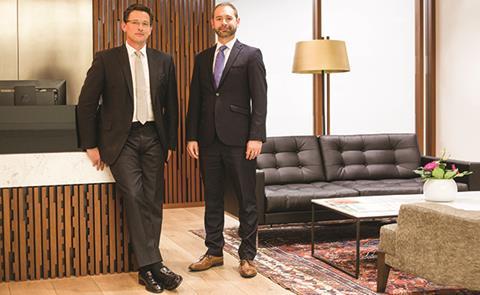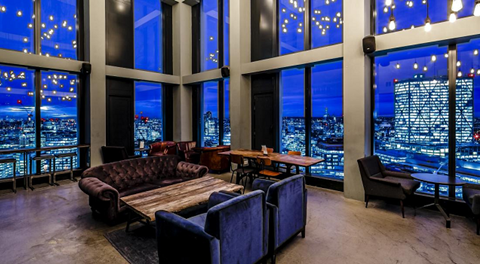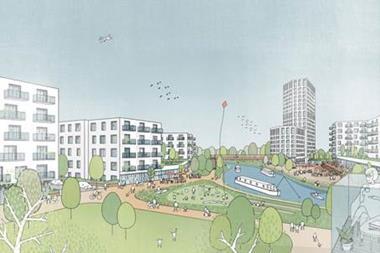To some, it is the private rented sector (PRS). To others, it’s the professional rented or build-to-rent sector. With the arrival of US giant Greystar in the market, another moniker is rapidly gaining traction: multi-family housing.

The rented property specialist currently has more than 400,000 units under management globally, equating to a $15bn (£12.2bn) investment portfolio. Almost half of this – $7bn – is in the US.
But having arrived in the UK 18 months ago and having built a sizeable student accommodation portfolio through its Chapter vehicle and involvement in iQ Student Accommodation, it is now ramping up its multi-family housing presence here.
Plans to develop a 2,000-unit scheme in Greenford in west London mark the first step towards its goal of having 10,000 multi-family units under management in the UK by 2021.
If managing director of investments Mark Allnutt and development director Matthew Crichton-Brown get their way, Greystar will be delivering a Greenford-scale project every year and we will all be talking about multi-family rather than the PRS before long. But aren’t the terms different for a reason? Can Greystar really transplant the US model lock, stock and barrel to the UK?

On the surface, there seems little difference between the multi-family model advocated by Greystar and the traditional UK approach to the PRS. However, Allnutt says there is a clear distinction between the two models.
“What sets it apart from other residential is that it is managed and serviced in an institutional manner by an institutional landlord,” explains Allnutt, who in a previous incarnation was a founding director of PRS specialist Fizzy Living.
“It’s multi-family in mind from its inception, so it’s designed for rent from the outset. This is about world-class customer service that creates support and loyalty from the customers.”
It is the sort of rationale you will hear from any number of PRS firms in the UK, who all believe they have a superior product – and Allnutt accepts that. “Absolutely, there are a lot of guys striving for the same thing,” he says.
Multi-family housing works at scale. That’s where you get the efficiencies – Mark Allnutt
The difference is scale, he argues. If Greystar wins approval for its Greenford project, which will go before Ealing’s planning committee this month, the market would instantly be boosted by nearly 2,000 units. The smallest block would have 215 homes, with the largest featuring 350.
“Multi-family housing works at scale. That’s where you get the efficiencies around the operations and that enables you to have the right level of customer service, the right level of staff and the right level of amenities,” Allnutt explains.
Emphasis on customers
Those efficiencies of scale allow Greystar to deliver a level of service few others can match, claim Allnutt and Crichton-Brown. Greenford, for instance, would have separate leasing staff for each block, dedicated staff to help new movers check in and on-site maintenance.
“You ring down to the front desk, say something needs fixing and it will be fixed within a day or two – there are no external contractors,” he says.
Each block would also have a gym to rival the best fitness facilities in the area. “The resident doesn’t have to join a gym because their gym is as good as that – that’s achievable by scale,” says Allnutt, adding that the idea is to create fully fledged rental communities and that Greenford will also boast a school, health centre and supermarket, alongside other retail and workspace.

As in the US at the moment, but less so in the UK, where there remains scepticism about the level of demand from UK renters, the emphasis will be very much on customer service.
“All the best parts of the building are reserved for the residents,” says Crichton-Brown. “Instead of having a penthouse, we’ll have a clubhouse with an exhibition kitchen. You could have a library, a games room or a cinema room.
“If you’re a resident you can suggest an event you’d like to have – a lecture you’d like to put on, or a book club, or a yoga class – and it could potentially be facilitated within the buildings and the amenity space.”
It all sounds very American – and indeed, the pair say their UK developments will be very similar to their US counterparts, not to mention slightly bigger than most new apartment blocks in London.
Snapshot:
Mark Allnutt
Managing director, investments
- Group commercial director at Thames Valley Housing Association from July to November 2014, before joining Greystar
- Founding director of Fizzy Living between February 2012 and November 2014
- Spent nearly seven years at Reading Borough Council as a senior development manager
- His first job was in his family’s carpentry business, Allnutt Carpentry
Matthew Crichton-Brown
Development director
- Before joining Greystar he was managing director of Coolong Real Estate, a development advisory company
- Previously, he was group development director at Londonewcastle for seven years from 2003
“You shouldn’t have bedrooms backing on to bedrooms – it’s individual bathrooms for individual bedrooms; those design elements drive the size of the units, which can mean they’re a little bit more generous,” says Crichton-Brown. Allnutt adds: “Customers like the size of the cupboards, the size of the bathrooms, the size of the washer-dryers.”
However, some experts have warned that taking the service renters enjoy in the US and plonking it in London simply won’t work. UK renters, they argue, want a simpler approach focusing on ease of leasing and price rather than expensive bells and whistles.
Allnutt recognises the need for a “local cultural spin” on the model. He also underscores the importance of local expertise and points out that the UK team is very much leading the charge in London, where less than 10% of its office staff are from the US. “We had a heavy US involvement at the beginning and then we looked to hire local expertise,” he says.
The theory, whether in London or California, is that a focus on customer service instils loyalty and that tenants will therefore stay in their homes for the long term. That also benefits investors, Allnutt claims, because they have guaranteed stable income.
Diverse tenant mix
Another key ingredient is a diverse tenant mix and the sense of community this creates. While most PRS blocks are packed with young professionals, Greystar is hoping to encourage all ages into its scheme, primarily through the design of homes, through a marketing campaign targeting a broad demographic and through price and flexibility of tenure.
To this end, it plans to offer 30% affordable housing and nearly a third of the units, separated in different blocks to the rest, will be available for sale.
We’re not here to do one or two deals; we’re looking to have 10,000 apartments under control by 2021 - Mark Allnutt
Again, it is scale that allows Greystar to offer competitive prices. “There’s a debate, a discussion in the PRS space right now about affordable housing, what tenure it should be for PRS, and those arguments all fall away when you develop at scale, because it gives you the opportunity to provide a range of tenure,”says Allnutt.
He hopes that by attracting a wide mix of people, Greystar will be able to emulate what it has achieved in some of its UK student accommodation schemes such as the 1,000-unit Chapter scheme it operates in Spitalfields.
“The energy is amazing. You go in the building and you can feel it: it’s electric, it’s crazy, it’s off the charts, and that’s because people like the environment,” says Allnutt. “They like the amenities, they like the service, they bring their friends to see it. We want to bring that to multi-family.”
The plan is to roll the model out across all its new PRS sites and the team is currently looking for other brownfield sites in London. “We’re working on a pipeline – we’re very acquisitive,” says Allnutt.

“We’re not here to do one or two deals; we’re looking to have 10,000 apartments under control by 2021. We’d love to do a Greenford a year if the sites are available.”
It is a grand ambition, but Greystar says it intends to pull out all the stops to achieve it. As well as buying public land, it wants to work with City Hall and team up with TfL, which would require it to get on to the organisation’s approved panel of developers.
“That’s the type of body and landowner that we’d be really keen to work with,” says Allnutt.
Given Greystar’s track record, public bodies will no doubt be beating a path to its door. The question is: will UK renters buy into the large-scale, US multi-family housing model – or favour the smaller-scale, UK approach to the PRS?
Greystar’s place in the property firmament could well depend on the answer to that question.





























No comments yet